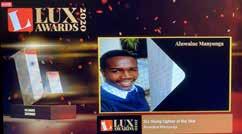
2 minute read
NEWS
THE LATEST NEWS AND STORIES
ZIMBABWEAN ENGINEER WINS YOUNG LIGHTER
Advertisement
Aluwaine Manyonga has won the Young Lighter 2020 competition following the virtual final that formed part of the LUXLive 2020 Digital Festival in November.
Manyonga, who works for Emmanuel Consulting Engineers in Zimbabwe, looked at offgrid solar lighting in Africa, nearly 50 per cent of which does not have access to the grid, and where one in three students goes to school without any type of electricity. He focused on the Chigubhu lantern, Africa's 'education system game changer', which involves using recycled plastic containers and reuses electronic waste, as well as using solar power.
The SLL Young Lighter 2021 competition is now open for entries: www.cibse.org/society-of-light-and-lighting-sll/sll-events/sll-young-lighter
DYNAMIC NEW APPROACH TO WORKPLACE LIGHTING
Fagerhult, iGuzzini, Tridonic and Zumtobel are among companies working with Aalborg University in Copenhagen to develop a new approach to workplace lighting. The Double Dynamic Lighting (DDL) research project focuses on illumination that combines direct and diffuse dynamic daylight with artificial light. 'The aim is to apply an innovative mix of methods to create a holistic approach to lighting planning which can then function as a seal of quality in the lighting industry,' says Prof Ellen Kathrine Hansen (above), head of lighting design in the Department of Architecture, Design and Media Technology.
https://vbn.aau.dk/en/projects/double-dynamic-lighting Photographer Of The Year.
ON THE LIGHTER SIDE...
Glass worms, lake-dwelling midge larvae, apparently use light to regulate the depth of their immersion in the water. Large tracheal bubbles serve as swim bladders. They are covered with dark pigment cells that expand due to absorption of light, heating up and increasing in volume, reducing the weight of the larva and causing it to float up. The image was taken Micro category of the 2020 Close-Up
by Andrei Savitsky who won the www.cupoty.com OBITUARY
It is with great sorrow that I report the death of Dr John W Frost, MBE. I met John when I joined the Illumination Laboratory of the Hirst Research Centre back in 1959. Luminaire photometry was one of the main issues of the day, alongside luminaire design.
But John’s major input to the lighting profession was in education; first at the Borough Polytechnic, later to become the London South Bank University, providing the Illumination Engineering Society (IES) with a diploma course for engineers to inform about lighting science of the day.
Later he was awarded a doctorate by South Bank University for his work in luminaire photometry, particularly resolving the minimum distance of measurement for accurate intensity values of around 3m, confirming the advice of JM Waldram.
In addition, he provided a service to luminaire manufacturers without the necessary photometric equipment, as well as offering courses for more advanced students.
Following his retirement, he was asked to provide courses for the then Lighting Industry Federation, now the LIA, many of which were held in the lecture room at CIBSE headquarters.
It is without doubt that there will be many current senior members of the lighting industry who benefited from the courses as well as beginners. His ability and enthusiasm for the subject was of great proportions and for his work he was awarded an MBE.
David Loe







